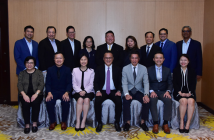During September 2013, Executive Editor, Chris Cubbage, visited global security giant Lockheed Martin’s facilities across the USA for briefings on its business activities in the space, aerospace, maritime, cyber intelligence and defence domains. Special thanks to Trevor Thomas and Lockheed Martin International for the privilege. Here is Part 1: An insight into the business of Lockheed Martin International.
Business overview
Lockheed Martin International (LMI) is a leading, global security solutions company with a vast security and defence portfolio.
At the forefront of a defence powerhouse and the largest contractor to the United States Military, with 2012 revenues at USD$47 billion, Rick Kirkland, Vice President (VP), Business Development for LMI in Washington DC, outlined the key driver for the business has been the significant shift in global defence spending, with a clear migration to a security solutions focus. Spending is down in the US and Europe, remains stable in the Asia Pacific and is trending upwards in Africa and the Middle East. Not surprisingly, China and Russia are not on the client list but LMI is active with immediate US allies, in Canada, Australia, Singapore, Philippines, Japan and Korea.
LMI’s relationships and businesses are broad, topped by the multi-billion dollar rollout plan for the F-35 Joint Strike Fighter, preparing to launch the latest GPS III Satellite in 2014, signing a USD$223 million deal in April 2013, with South Korea for high-end imagery sensors, and opening its fourth Security Intelligence Centre in Canberra, Australia, in early October 2013. The ‘international’ focus of the business didn’t occur until July 2013, but was a natural, if not surprisingly, late transition. With 350 supplier and contractor partnerships around the world, they’re working on more than 3,000 programs, collectively worth more than US$30 billion.
The key take away is that LMI is not just an aerospace manufacturer. It is also the largest IT provider to the US Government and writes more lines of code per day than Microsoft. With 27 offices world-wide, 116,000 employees, 60,000 scientists, 500+ facilities in 70 countries, the company has an education program from kindergarten through to Doctorates.
Just a few weeks prior to the US Government shut down on October 1 2013, Greg Walters, VP Legislative Affairs, provided insight into the US Congressional Engagement Process. With 94 percent of LMI’s business with the US Government and only five percent with Foreign Governments, LMI has 24 lobbyists working with 88 select US Congress committees and will generally be called to appear before all of them at some point during budget deliberations. The process is heavily bureaucratic and involves budget resolution, with sequestration a critical budgetary issue. Any budget resolution is followed by an Authorisation Process and then an Appropriations Committee. At the time, congressional priorities LMI faced were with difficulties around undecided defence plan rationality, lack of investment commitments and resulting issues for recruitment, project planning and delivery projections.
Sequestration in the US came into effect in May 2013, and requires defence, along with all sectors of Government to cut spending by ten percent per annum for the next ten years. With a US$500 billion defence budget, that’s US$50 billion to cut. By the time the 2014-2015 financial year rolls around, it will most definitely start to have an impact on LMI and other major defence contractors. Ultimately, it will result in program and personnel cuts. Programs could be cut between 10-15 percent and the worst case is an impact on the F35 related programs. There reportedly remains strong Congressional support for the F35 project with Senators Dr Ash Carter and Frank Kendall, suggesting the F35 will be protected, however, some committees are raising concerns around the software block delivery. LMI staff numbers have already been reduced from 147,000 down to 116,000.
On the radar for the company’s leaders is the progressing Iranian nuclear program, Middle Eastern and North Africa conflicts, more than 30 active campaigns attacking its cyber networks and the ongoing, ominous threat of sequestration and securing a minimum funding arrangement. Trouble for LMI is that if sequestration continues, then it may take until the next administration to solve – and that’s three years away. As it happened, LMI warned earlier this year (2013) that automatic spending cuts, included in the sequester, would cost the firm about $825 million. But Chief Financial Officer Bruce Tanner, informed media in October 2013, post the Government shutdown, that the impact was about half that. The Government shutdown, which was not included in the company’s earnings report, cost LMI between $15 million to $20 million per week.
Space Systems Company
In mid-September 2013, fresh from having returned to Santa Clara, California, from the World Satellite Business Conference in Paris, Linda Reiners, President of Commercial Ventures for LMI’s Space Systems Company, proudly provided an overview of some of the most exciting and challenging technology in use today. Special developments are being made in nano technologies, optics and electro-optics, telecommunications, modelling and simulation, phenomenology, precision pointing and control and materials development (3D printing).
Nano technology (carbon nano tubes used for circuits) provides plastics to replace metal and applying 3D imaging using laser technology. With all that technology in mind, LMI’s Space System’s business units are categorised into Civil Space, Military Space, Subsidiaries, Commercial Ventures, Advanced Technology and Special Programs.
Whilst in Paris, Reiners announced technical updates to the A2100 Satellite addressing design architecture and manufacturing processes, offering satellite operators catalogue-to-order solutions that leverage common parts, sub-systems and components to meet specific customer and mission needs. Standard interfaces across LMI’s satellite programs now streamline spacecraft integration and minimise non-recurring engineering costs. There are already 45 A2100 spacecraft in orbit, including 39 commercial satellites and six satellites performing US Government missions. The fleet is equipped with more than 1,500 transponders transmitting data, video and audio for satellite operators world-wide.
The satellite platform meets a wide variety of telecommunications needs, including Ka-band broadband and broadcast services, fixed satellite services in C-band, Ku-band and X-band, high-power direct broadcast services using Ku-band mobile and satellite services using EHF, UHF, L-band, and S-band payloads. Major mission areas include remote sensing, communications, wind energy and new ventures.
The oldest satellite is 17 years in orbit and the 7th generation 3-axis A2100 satellite will have a 1.1million optic camera – capable of seeing 1,000 kilometres with resolution to 0.5 metres. The International Space Station is under 400 kilometres from earth. That’s a capability to read this magazine on the ground from an outer low earth orbit.
LMI is clearly out to make space equipment, travel and related research cheaper, easier to access and gain benefit from. When asked if Moore’s Law applies in this field, Reiners replied, “It applies more to capabilities. Instead, when improvements in technology occurs, it tends to be revolutionary.”
One example is changing from tin to copper in satellites, where pure tin products developed tin whiskers causing reliability problems in electronics. The Galaxy IV telecommunications satellite was disabled and lost in 1998, due to related short circuits. Using copper revolutionised satellite technologies making them inherently more reliable and safer.
There are also ‘so-called’ HAG (Hairy Audacious Goals) concepts, where special projects and researchers do truly reach for the stars. But LMI remains a commercial enterprise, with some project plans out to ten and 20 years and a revised, post GFC business focus of driving costs down, seeking commonality and scalability, whilst also introducing efficiency and affordability.
Major developments into the future, with the odd HAG included industrial 3D printing of parts and ultimately sending ships into space with 3D printing capabilities to produce spare parts and indeed, other space vessels. Having been involved in every mission to Mars to-date and amassing 1,000 years of orbit experience, LMI is a key commercial leader in space exploration and the future is almost foreseeable.
Part 2 will provide briefings on LMI’s Strategic and Missile Defence, Solar Science, Information Systems and Global Solutions and Unmanned Aerial Systems, and will be published in the Feb/Mar 2014 issue of Australian Security Magazine.





